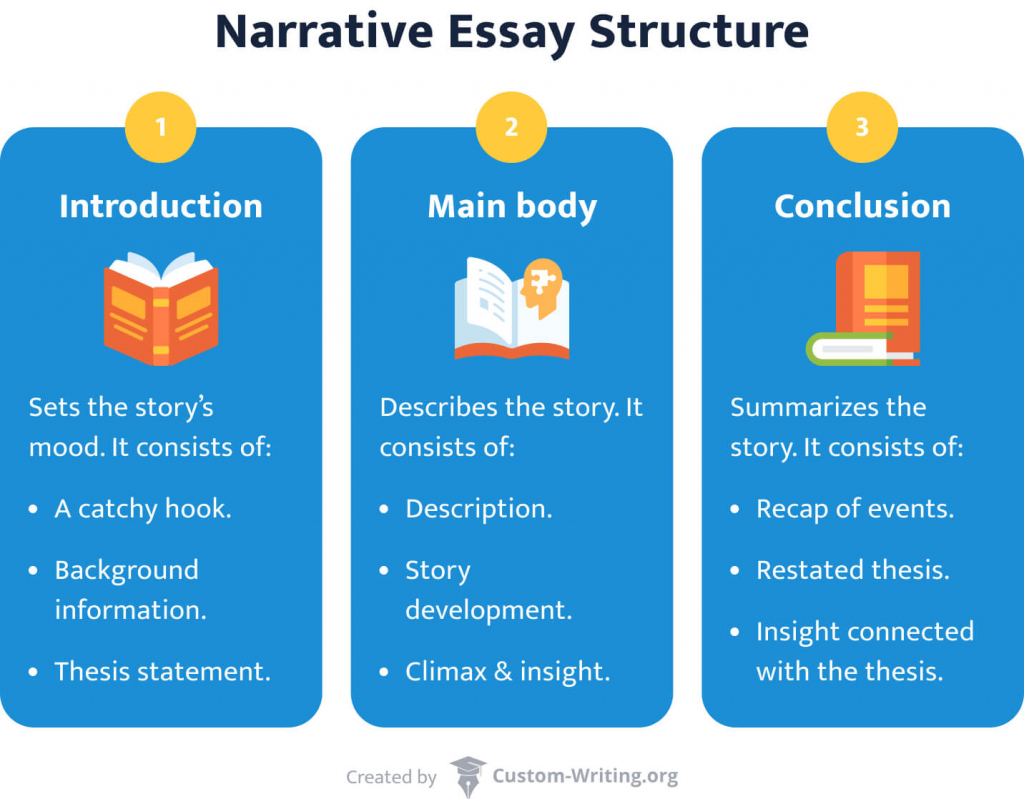Narrative essays are unlike anything you wrote throughout your academic career. Instead of writing a formal paper, you need to tell a story. Familiar elements such as evidence and arguments get replaced with exposition and character development. Though writing a narrative essay may seem intimidating to newbies, it’s actually easier than it seems. The best thing about it is its flexibility, allowing you to express yourself and be creative with the narrative.
Still, the success of any narrative writing project largely depends on consistent structuring and the flow of the content. By having a plan at your disposal, you’re sure to avoid going off-topic or skipping any vital details.
This guide by Custom-Writing.org will tell you about the ins and outs of composing a narrative essay outline. Here, you will find:
- A comprehensive description of narrative essay type.
- Expert tips on creating a great outline.
- A printable PDF template that you may use for outlining exercises.
📚 What Is a Narrative Essay? Definition & Components
A narrative essay is presented in the form of a story. It has the same goal as any other academic work: to prove a certain point. But it is very different from a regular paper, and here’s why:
Typically, you need to keep things formal and grounded in your essays. A narrative essay is an exception. While writing it, your inner artist is free to run wild. Vivid imagery and descriptive language will only make your essay more effective.
A narrative essay also has several unique components. These are as follows:
- Characters.
For a narrative to unfold, it must have characters who perform actions or interact with each other. This can involve the story’s author, other real or fictional people, and imaginary creatures. - Setting.
An action takes place in a place and time, which forms the setting. Capturing the context is important to help the reader immerse themselves in the narrative and comprehend the plot. - Plot.
Simply put, the plot is a sequence of events and interactions that propel the narrative forward. As a rule, narratives start with the introduction followed by the rising action, then move to the climax, and end with a resolution, often preceded by the falling action. - Conflict.
Conflict is what makes the narrative gripping. Characters may face inner turmoil or external struggles involving other people or outside circumstances. - Point of view.
This aspect depends on the speaker’s position in the story, which can be told as a first-person account or with a third-person omniscient narrator. Second-person narratives also exist, although they’re rarer than first- and third-person ones. - Theme.
The main theme or message is the unifying concept the author aims to convey via the story. It typically relates to a moral or ethical question viewed from the narrator’s perspective.
Now that you know what sort of assignment you’re dealing with, you can start selecting a topic and developing your outline.
✅ Choosing a Narrative Essay Topic
Choosing a topic is a key aspect of writing a great narrative essay. A good topic should be creative enough to allow the full development of a plot, characters, and themes. Here are the main steps that will help you make the right choice.
Brainstorming
To come up with a workable topic, it’s a good idea to brainstorm first. Here’s how it works:
- Reflect on personal experiences. Best narratives often come from personal stories and emotions. So, try to revisit various memories to pick one that has produced an impression on you.
- Make a list of memorable events. Think of unforgettable moments or life lessons. You can craft a vivid narrative from these events by listing the details and adding some fictional elements to them.
- Develop a central theme. Every narrative should have a central idea that the reader will get from reading it. This underlying idea will add a deeper layer of meaning to your plot.
Picking a Topic
Now that you have a list of prompts from the brainstorming session, it’s time to develop a workable topic from them. Make sure the topic is:
- Relevant. Connect it with the narrative’s main idea you want to convey.
- Engaging. Study your target audience’s scope of interests and choose a theme that will surely hook them.
- Significant. Pick a topic that touches upon genuinely important problems or issues so that it resonates with your readers.
By following our tips, you’re sure to proceed with the writing process quickly and smoothly.
✍️ How to Write a Narrative Essay Outline
First, you should understand what type of narrative you want to create. There are 2 options you can pick from:
- Personal experience. It’s simpler to write about since you don’t have to come up with anything new. You only need to describe an account about yourself or about someone else that actually happened.
- A piece of fiction. This option is a bit trickier in comparison. It requires you to think up a whole story. Nevertheless, the results will likely be more satisfying.
Once you’ve decided on the type of narrative, you need to determine what sort of outline you want. It can be straightforward and minimalist with the essential elements only. Or, you can make it as comprehensive as you wish. It’s helpful to remember that a narrative essay is usually 5 paragraphs long: make sure not to go overboard or make it too laconic.
Now, let’s talk about the structure of your narrative paper’s individual parts.

Narrative Essay Introduction
Your introduction won’t be that different from that of a regular essay. You need 3 things here:
- A hook to captivate the readers’ attention;
- Some background information pertinent to your story;
- A thesis statement introducing your essay’s main point.
How to Start a Narrative Essay
First and foremost, your essay needs a catchy hook. It’s a captivating sentence that aims to grab the reader’s attention. While a piece of statistics or an interesting fact can serve as a good hook for an average paper, it’s too plain for a narrative essay. So, we need to go a bit more creative.
Say you are writing an essay about the influence of music on a person’s views. The core of your essay is a story of you visiting your first classical concert. One option is to start with a question. Asking something immediately evokes the need to answer. It also stimulates interest along the way.
Furthermore, questions make the transition into the background info easy and smooth. Just answer the hook question:
Example:
Hook: Do you remember going to your first concert?
Background: I sure do. It was a magnificent evening on the first weekend of spring. The only thing I was skeptical about was the concert itself. I was not the greatest fan of classical music; rather, I was not too fond of those who enjoy it. I thought of them as arrogant and selfish.
Make sure not to start telling about the events of your story in the introduction. Instead, you can tell what preceded it or just set the mood. If you’re looking for more ideas on how to start an essay, be sure to check out our article on hooks in writing.
Narrative Essay Thesis Statement
The thesis statement of a narrative essay answers the question, “What am I trying to say with this story?” It conveys the main idea and can be formulated in various ways. It can be your regular thesis with the main point and arguments. But don’t forget that you are writing a story. This means you can make your thesis a part of the narrative; build it as a starting point of your account or showcase the lesson you’re about to learn.
Have a look at these narrative essay thesis examples to get a better idea:
Example:
If only I knew the power music holds and how it can dramatically change one’s perception of things.
Example:
I didn’t know yet that this event would change how I saw classical music and its fans.
You might want to formulate the thesis and put it into your outline before everything else. This way, it will be easier to write your story around it.
Narrative Essay Body Paragraphs
After you’re done with the thesis, you can continue your story and prove the main argument. There are 2 ways to go about your essay’s body paragraphs:
Option 1: Make each paragraph into an individual story.
✔️ Pros: This structure allows you to use several arguments related to different storylines.
❌ Cons: In this case, you’ll need to structure your essay’s body densely in order not to make it too long.
Option 2: Use the whole essay’s body to tell a single story.
✔️ Pros: This way, it’s easier to structure the body of your essay.
❌ Cons: Since you are limited by a single story, your argumentation becomes weaker.
Whichever way you choose, you need to remember the general storytelling rules:
- Describe things in chronological order. Make sure that the events of your story follow each other coherently.
- Don’t break the general “introduction-development-conclusion” structure. As long as your narrative has these 3 elements, you will have a decent story.
Here’s what you can write about in your narrative essay’s body paragraphs:
- It’s always a good idea to start with a description of things. It creates necessary immersion and makes the reader more involved with the story.
- You can also dedicate the first paragraph to setting up the characters of your story (if there are any.)
- The following two paragraphs are about developing, culminating, and ending your story.
In the case of a classical concert, an average body outline sample can look like this:
Paragraph 1
Here, you begin your story and describe the concert hall and the people inside it.
Paragraph 2
Now, you develop the story. For example, mention your friend whom you didn’t expect to see at such an event.
Paragraph 3
In this paragraph, you can culminate your story with an insight that demonstrates a more profound realization of the idea in your thesis. For instance, your friend is very humble and grounded. However, he is a big fan of classical music. You realize that your prejudice towards classical music fans is wrong.
Narrative Essay Conclusion
The conclusion of your story summarizes the body of your essay. It also restates your thesis in a paraphrased form. Make sure not to add any new info to your outline at this stage. The conclusion is only there to sum things up and draw attention to the most important points.
In a narrative essay conclusion, it’s a good idea to mention the insight and demonstrate its connection to the thesis. In the case of our classical music essay, it could look like this:
Example:
This is the story of my epiphany on the connection between music and personality. Judging people by their music taste turned out to be a gigantic mistake. But I am happy to have made this misstep since it helped me learn an important lesson.
📝 Narrative Essay Outline Template
Now, let’s see what we have in the end. Have a look at the following narrative essay outline example:
- Introduction
- Hook. It’s a catchy and intriguing sentence. An interesting question or a surprising fact will do.
- Background information. This means everything the reader needs to know before diving into the main part.
- Thesis statement. It can be a generic thesis or a poetic sentence that demonstrates your point.
- Body paragraphs
- Description paragraph. It’s a paragraph that helps the reader visualize your story. You can also introduce the characters here.
- Story development paragraph. This is the part where you develop the established characters and storyline.
- Story climax and end paragraph. It’s a part that contains the highest point of your narrative and its logical end.
- Conclusion
- Summary. Briefly conclude the events described in your body paragraphs.
- Restated thesis. Paraphrase your main claim and provide a deeper understanding of the insight.
You can download a 5-paragraph narrative essay template in PDF format using the link below. It can be very helpful for outlining your essay: simply print it out and fill in the blanks.
Example:
- Your essay’s title.
- Start with a catchy and intriguing sentence.
- Provide some background information about the topic.
- Write a strong thesis statement that demonstrates your point.
We’ve also gathered some narrative essay examples for you to gain inspiration. Check them out below!
- Literacy Narrative: “Make a Wish”
- Multimodal Personal Narrative: The Path to the Goal
- Clinical Narrative: Conversation With a 30-Years-Old Woman With Diabetes
Literacy Narrative Outline Template
A literacy narrative is a story that chronicles your experience of developing a particular skill. Usually, it refers to learning to read and write. The thing is to underline the importance of the described accomplishment.
- Introduction
- Hook sentence. As an attention-getter, you might use an interesting tidbit about yourself.
- Background information. Offer a brief description of the skill’s role in your life.
- Thesis statement. Compose a sentence stressing the importance of the skill you acquired. Use the thesis to show how your experiences have changed after learning it.
- Body paragraphs
- Description. Depict your life before discovering the skill in question.
- Story development. In the second body paragraph, concentrate on the learning process itself.
- Story climax and end. Now, you can close the story with your triumph. You can also compare “before” and “after.”
- Conclusion
- Summary. Briefly retell the story of learning the skill.
- Restated thesis. Remind the reader why the subject holds a personal meaning for you.
Feel free to download this template in PDF format using the link below.
Example:
- Your essay’s title.
- Start with a catchy and intriguing sentence.
- Provide some background information about the skill you’ve learned.
- Write a thesis statement that demonstrates the importance of the skill you’ve learned.
Narrative Essay Topics
- My experience of learning English
- My first time riding a bicycle
- A defining event from my childhood
- My personal methods of handling stress at high school
- My experience with attending the logic course
- My experience with writing
- A personal experience of mysophobia
- Experiencing mystical events
- Lesson learned in college as a nursing student
- The impact of the English writing course on my academic success
- What has working in Walmart taught me?
- The importance of college experience for a career in healthcare
- Virtual concert impression
- Lincoln Center Orchestra’s online concert experience
- My opinion on Simmers restaurant service
- My favorite form of literature
- My experience of working with children with autism
- My memories of the first day in college
- College as the first step of my professional development
- College experience as a nursing student
- What my first semester has taught me
- The most memorable childhood holiday
- My most memorable college teacher
- The first time I attended a rock concert
- My impression of piano music concert
- My expatriation experience
- What I’ve learned during my practicum
- Life of people of different races and age groups in the USA
- My personal financial plan
- My experience with attending court
- What I’ve learned working with catheter-related bloodstream infections
- S. Kruzan and C. Brown’s case in criminal justice system
- How my Senior Developer position contributed to my professional development
- The effect of the authoritative parenting style on my life
- My first job experience
- What I’ve learned working as a researcher in the company
- My personal experience and Erikson’s theory of development
- Hardships and benefits of a study group
- How I challenged gender norms
- The time when I was working as a head nurse
- The influence of Italian culture on me
- How I bought my laptop and the salesperson’s impact on my experience
- What I have learned during my trip to the Museum of Western Heritage
- How I spent a day without my cellphone
- Skills I’ve acquired during my practicum experience in New York Methodist Hospital
- My impression of visiting the Energy Medicine Florida
- The time I visited Yellowstone National Park
In conclusion, we would like to wish you good luck with your assignment! Make sure to comment on the things you’ve found the most useful.
Further reading:
- How to Write a Good Narrative Essay: Tips, Examples, & Step-by-Step Guide
- What Are the 5 Different Types of Essays? A Complete Guide
- How to Write a Creative Essay: Tips, Topics, and Techniques
- How to Write a Personal Essay: Topics, Structure, & Examples
❓ Narrative Essay Outline FAQ
How Do You Write a Narrative Essay Step by Step?
- Choose a topic for your essay.
- Decide on the type of your story (either personal or fictional.)
- Write an outline. Make sure to come up with the thesis first.
- Write your essay.
What Is the Purpose of Dialogue in a Narrative Essay?
The purpose of any dialog is to demonstrate a conversation between people. Showing your characters having a conversation can help you develop them. You can also use dialogues to advance your story.
What Are the 4 Ways You Can Start a Narrative Essay?
Some possible starters for your essay are:
- Asking the reader a question.
- Opening up with a joke.
- Revealing shocking information about the events described further.
- Telling your readers an interesting fact about the topic of your essay.
🔍 References
- Narrative Essays: Purdue Writing Lab
- How to Write a Narrative Essay: Writers.com
- Narrative Essay: Nova Southeastern University
- Narrative Essay: Excelsior College
- Narrative Essay: Miami University
- Unique Characteristics of Narrative Essays: Oklahoma State University
- Descriptive Narrative Essay: Southeastern Louisiana University
- Narrative Essay Writing Prompts: California State University Stanislaus




![Critical Analysis Essay Example & Writing Guide [2025]](https://custom-writing.org/blog/wp-content/uploads/2021/10/business-men-sitting-lawyers-s-desk-people-signing-important-documents-284x153.jpg)





![Critical Writing: Examples & Brilliant Tips [2025]](https://custom-writing.org/blog/wp-content/uploads/2021/02/fingers-note-report-journalist-filling-284x153.jpg)

